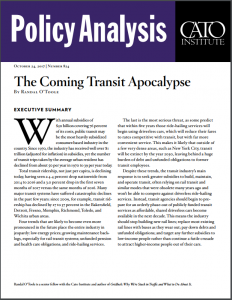Full Title: The Coming Transit Apocalypse
Author(s): Randal O'Toole
Publisher(s): CATO Institute
Publication Date: October 1, 2017
Full Text: Download Resource
Description (excerpt):
With annual subsidies of $50 billion covering 76 percent of its costs, public transit may be the most heavily subsidized consumer-based industry in the country. Since 1970, the industry has received well over $1 trillion (adjusted for inflation) in subsidies, yet the number of transit trips taken by the average urban resident has declined from about 50 per year in 1970 to 39 per year today.
Total transit ridership, not just per capita, is declining today, having seen a 4.4 percent drop nationwide from 2014 to 2016 and a 3.0 percent drop in the first seven months of 2017 versus the same months of 2016. Many major transit systems have suffered catastrophic declines in the past few years: since 2009, for example, transit ridership has declined by 27 to 37 percent in the Bakersfield, Detroit, Fresno, Memphis, Richmond, Toledo, and Wichita urban areas.
Four trends that are likely to become even more pronounced in the future place the entire industry in jeopardy: low energy prices; growing maintenance backlogs, especially for rail transit systems; unfunded pension and health care obligations; and ride-hailing services. The last is the most serious threat, as some predict that within five years those ride-hailing services will begin using driverless cars, which will reduce their fares to rates competitive with transit, but with far more convenient service. This makes it likely that outside of a few very dense areas, such as New York City, transit will be extinct by the year 2030, leaving behind a huge burden of debt and unfunded obligations to former transit employees.
Despite these trends, the transit industry’s main response is to seek greater subsidies to build, maintain, and operate transit, often relying on rail transit and similar modes that were obsolete many years ago and won’t be able to compete against driverless ride-hailing services. Instead, transit agencies should begin to prepare for an orderly phase-out of publicly funded transit services as affordable, shared driverless cars become available in the next decade. This means the industry should stop building new rail lines; replace most existing rail lines with buses as they wear out; pay down debts and unfunded obligations, and target any further subsidies to low-income people rather than continue a futile crusade to attract higher-income people out of their cars.
